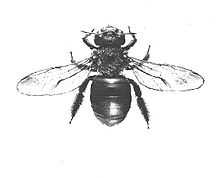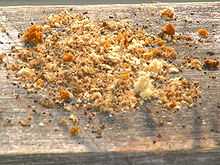Eastern carpenter bee
| Eastern Carpenter Bee | |
|---|---|
 | |
| Female Xylocopa virginica on Salvia | |
| Scientific classification | |
| Kingdom: | Animalia |
| Phylum: | Arthropoda |
| Class: | Insecta |
| Order: | Hymenoptera |
| Family: | Apidae |
| Subfamily: | Xylocopinae |
| Genus: | Xylocopa |
| Subgenus: | (Xylocopoides) |
| Species: | X. virginica |
| Binomial name | |
| Xylocopa virginica Linnaeus, 1771 | |
| Subspecies | |
| |
The common eastern carpenter bee, Xylocopa virginica, is the carpenter bee most often encountered in the eastern United States. It is often mistaken for a large bumblebee species, as they are similar in size and coloring. They can be important pollinators, especially of open-faced flowers, though they are also known to "rob" nectar by boring holes in the sides of flowers with deep corollas (thus not accomplishing pollination). They sometimes bore holes in wood dwellings and can become minor pests. They use chewed wood bits to form partitions between the cells in the nest.
Appearance


The most visible physical difference (at a glance) between this species and a bumblebee is the abdomen. Eastern carpenter bees have a shiny black abdomen, with the only yellow hair present being at the base next to the thorax, while bumblebees have a very fuzzy abdomen, which in some species has large areas of yellow hair across the middle (this is visible and obvious). The female eastern carpenter bee also has a much broader head than bumblebees. Eastern carpenter bees can be sexed at a glance. Males have a patch of white or yellow cuticle on the face, as opposed to females, whose faces are black. Males are unable to sting, since a bee's stinger is a modified ovipositor (an egg laying organ).
Nesting
Female carpenter bees make nests by tunneling into wood. They make an initial hole in an overhang, eaves trough, or similar structure, tunneling upward if the grain is horizontal and sideways if the grain is vertical. Then, they make one or more tunnels at a right angle. The final nest usually resembles a T and can have up to three T-shaped layers. Unlike termites, carpenter bees (also called woodcutters) do not eat wood. They discard the bits of wood, or use them to make partitions (walls) inside the tunnels of their nests. The tunnel functions as a nursery for brood and the pollen/nectar upon which the brood subsists.
Males will visit flowers only to feed themselves, spending the rest of the time hovering in their territory and investigating any movement, or guarding flowers where they might encounter females. Females spend the majority of their time gathering nectar and pollen to provision their nests. They also regurgitate some of the food to male relatives during the mating season, in the males' roosting sites.

Because of their value as pollinators some people allow carpenter bees to stay around the home in the early spring, living with the cosmetic damage caused. In some fruit growing areas carpenter bee populations are encouraged by supplying them with suitable blocks or boards of soft wood.

In the eastern U.S., Xylocopa virginica overwinter as adults inside the same tunnels where they hatched that summer. In spring, they awake. The males adopt one of multiple mating strategies, but mostly hover around looking for mates. Females enlarge the existing tunnel, create a new tunnel in the same nest, or move nearby and start a new nest. They create separate partitions in the tunnel out of woven bits of wood fiber. They provision each partition with a paste-like wad of pollen and nectar, lay one egg on it, and seal it off. They make a variable number of these partitions in a nest, as few as 1, often 4 to 6, but sometimes up to 13. Each egg hatches into a grub-like larva which eats the pollen mass. It then pupates, which hatches into an adult bee in mid- to late summer. The newly hatched adults break through the partitions and crawl over each other to escape to the outside world. Usually, they do not then disperse, but continue to live in the tunnel, preparing to hibernate. Thus, the piece of wood is inhabited by bees year-round.
Active nests in a wooden construction occasionally cause considerable damage, but usually most of the damage is caused by woodpeckers searching out larval bees.
Most carpenter bee nests are easy to spot. The bees bore highly polished holes about 1 cm (about 3/8 in.) in diameter directly up into the bottom a nesting substrate (usually an eave, picnic bench or similar wooden structure). The interior of the tunnel generally is larger in diameter -- about 1.25 cm (1/2 in). When the female is boring tunnels, there is a collection of fresh sawdust below the hole. Occasionally one can hear the sound of boring and often also the sound of warmth-generating vibration inside the nest. The bees often leave visible yellowish splashes of fecal material below the entrance.
Deterrence
Pollinator decline is a serious environmental issue and carpenter bees are being valued increasingly as important pollinators.
The eastern carpenter bee is faithful to its home, preferring to lay eggs in the same hole it was born in and hibernated in. Females who leave the natal tunnel prefer to live nearby, often digging a new hole a few inches away in the same piece of wood. Over many years, the bees may almost completely hollow out a single board, or a few boards, without ever touching adjacent pieces. Thus, carpenter bee habitations tend to remain in one area. Because each female produces only a few young bees each year, their numbers grow slowly.
Wood is sometimes stained or painted (paint being more effective) to dissuade carpenter bees from attacking valuable wood, as bare wood is very inviting to a bee looking for a place to start a new nest. Painted flashing or screening on the edges of wood is sometimes used when paint alone fails. However, X. virginica will nest in almost any soft wood, particularly if it is exposed to the sun. Blocking or poisoning nests can be ineffective, as, since previous nests are the primary nests each year, the carpenter bees are encouraged to bore new nests. Over time the burrowing of these new holes may weaken structures. Sometimes people set out sacrificial pieces of bare wood to be used for nests in the place of more valuable wood.
Behavior

Carpenter bees are not solitary bees, but are not truly social either. The weak form of sociality they exhibit, with one female doing the majority of the work, and caring for her sisters, may be a transitional step in the evolution of sociality. However they tend to be gregarious, and often several will nest near each other.
Male eastern carpenter bees are curious and will investigate anyone, including humans, that comes near their nests. The curiosity is often interpreted as aggressiveness; however, the males are only aggressive to other male carpenter bees. They do not have stingers and cannot cause any real harm. The female carpenter bees tend to be busy with floral visitation and nest provisioning, but have the ability to cause a painful sting if captured.
Males spend many hours guarding their territory against other males, hovering about the nests for hours on sunny days. They sometimes attempt to mate with other insects or small birds.
An interesting trick to use to "move" a male carpenter bee out of the way is to pick up a small pebble (roughly the size of the bee), then toss it past the bee. They will attempt to chase it, distracting them for a few moments, long enough for a human to get by. However, since they cannot sting, and rarely accord any attention to humans, this is unnecessary.
Carpenter bees are strong fliers, capable of returning to their nests from some miles away, but not very agile. They tend to be clumsy, frequently almost crashing into the side of a wall or various trees and plants. On occasions, the bees will fly into old windows made of acrylic glass, as UV light can pass through it and the bee sees it as open.
Carpenter bees are not aggressive. Often, a carpenter bee preoccupied with something will not sting or flee when approached closely or even touched by a human, but merely raise one or two of its legs in the air instead.
Further reading
- Mitchell, Theodore B. (1962): Bees of the Eastern United States. Vol. II, The North Carolina Agricultural Experiment Station, Tech. Bul. No.152, pp. 557 (p. 507 ff)
- Balduf WV, 1962. Life of the carpenter bee, Xylocopa virginica (Linn.) (Xylocopidae, Hymenoptera). Annals of the Entomological Society of America 55:263-271.
- Barrows EM, 1983. Male Territoriality in the Carpenter Bee Xylocopa virginica. Animal Behaviour 31: 806-813.
- Barthell JF, Baird TA, 2004. Size variation and Aggression among Male Xylocopa virginica (L.) (Hymenoptera: Apidae) at a Nesting Site in Central Oklahoma. Journal of the Kansas Entomological Society 77:10-20.
- Gerling D, Hermann HR, 1976. Biology and Mating Behavior of Xylocopa virginica L. (Hymenoptera, Anthrophoridae). Behavioral Ecology and Sociobiology 3:99-111.
- Sabrosky CW, 1962. Mating in Xylocopa virginica. Proceedings of the Entomological Society of America 64:184.
- Rau,Phil, 1933. The Jungle Bees and Wasps of Barro Colorado Island: with notes on other insects, Chapter VIII: The Behavior of the Great Carpenter Bee, Xylocopa virginica with notes on the genesis of certain instincts.
External links
| External identifiers for Xylocopa virginica | |
|---|---|
| Encyclopedia of Life | 1045713 |
| Also found in: Wikispecies | |
- OSU Agricultural Extension Fact Sheet - HYG-2074-06
- Carpenter Bees - Penn State Entomology Department Fact Sheet